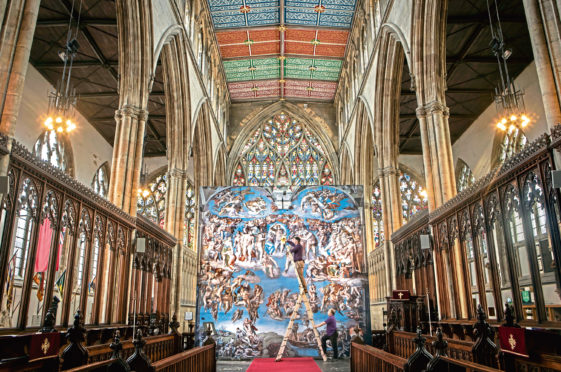God’s outstretched finger sparks life into Adam on the ceiling of the Sistine Chapel. After all that time on his back, Michelangelo would be scunnered to know tourists just see the hands.
The idea of God reaching down and doing things to Earth appeals to some Christians. Less ecumenical, more Old Testament – a judgmental God. It is this character that Scotland’s top freemason was thinking of when he mused on the divine role in the virus.
Coronavirus wouldn’t have been a proper disaster if some extremist hadn’t come out and linked it to God’s wrath. No sooner were we missing the absence of the comedy pastor in this story than along came Ramsay McGhee, grand master mason.
I shouldn’t mock. I’ll never get down the stairs of a police station safely again. But ex-cop McGhee linking the virus to secularism was gold class bonkers. A Christian welcoming people to the faith by suggesting God kills people.
The masons value the connection of hands with a range of different shakes, encoding seniority according to what knuckle is touched. A well-known MP greeted me this way at Loch Rannoch Highland Games once. Shocked, I told a friend, who explained that he thought the man had arthritis and it was involuntary. As that remains the only funny handshake I’ve known, I must broadcast a sense of not being part of the Great Architect’s plan.
Shaking hands is loaded with significance for men. A solid handshake is good, a weak one so bad as to leave a shiver of creepiness.
At the posh school I was sent to we had to attend a class given by the leader of a religious faith, who would tell us about manliness. It came down, he said, to the handshake. A firm grip with brief but determined eye contact signalled that one day you might rename large parts of Africa after yourself or single-handedly repel the Boche with a teaspoon.
So certain was he of this, he made us line up and shake his hand, giving scores for effort. In time, he was identified as a paedophile and we, on balance, got off lightly. Later the school’s headmaster was also revealed as having an unhealthy interest in children. What was most shocking about that was it turned out all the parents knew but wanted to give the headmaster a second chance after he’d been thrown out of a top English public school for failing to contain his desires. Seriously, the 1970s, what were my parents thinking?
Mind you, my father also found the handshake significant. In the late 1980s I greeted a friend with a handshake and he commented that it seemed “strange”, hinting it was too “continental”. It was said in the same tone used to describe suede shoes – something a bit effete.
As he’d studied at a university full of gay men, many of whom he’d befriended, and enjoyed the Continent, it was not entirely clear what his problem was but he claimed that Scottish men only shook hands when outside a kirk or in a bank. He thought there had been a cultural shift toward handshaking in the 1980s and disapproved.
I thought handshaking began in the English parliament, where it signalled you were not holding a sword. In fact, stone reliefs from Ancient Egypt and Greece depict men shaking hands. I’d like to say the classical education my parents paid for taught me that but all I learned at school was how to spot predatory men. Instead, I looked it up on Wikipedia.
I also recall a story about President Jefferson encouraging people to shake his hand as a sign that he was a man of the people, but cannot remember the source.
The handshake is the pledge of honour and the sporting show of camaraderie. For a long time it was the only tolerated form of male-to-male contact but that too has changed. Some time around 2003 men started hugging. This was so radical that anyone over the age 40 recoiled at the sight.
Men started doing handshakes plus shoulder bumps, grandsons dared to hug their grandfathers, grown men hugged their mothers. This may sound silly but it was a massive change in our macho culture. Teenagers now think nothing of friendly male contact but I grew up never hugging anyone other than my mother, until I was six.
Scottish men deprived themselves of human contact because it wasn’t “manly”. That was cruel and stupid and harmful. Which is why the virus marking the end of the handshake and hug is such a sadness. By February 2020 emotionally stunted men had come to accept the simple pleasure of freely expressed friendship. By March 2020 that had stopped.
The handshake became the spreader of disease. Human contact was a risk. Until there’s a vaccine, it may never return. Perhaps Michelangelo had it right. God’s hand comes down, but it doesn’t touch Adam’s. It’s almost like he knew we were all doomed from the beginning. Consider that, Mr McGhee.











